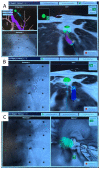Transbronchial Techniques for Lung Cancer Treatment: Where Are We Now?
- PMID: 36831411
- PMCID: PMC9954491
- DOI: 10.3390/cancers15041068
Transbronchial Techniques for Lung Cancer Treatment: Where Are We Now?
Abstract
The demand for parenchyma-sparing local therapies for lung cancer is rising owing to an increasing incidence of multifocal lung cancers and patients who are unfit for surgery. With the latest evidence of the efficacy of lung cancer screening, more premalignant or early-stage lung cancers are being discovered and the paradigm has shifted from treatment to prevention. Transbronchial therapy is an important armamentarium in the local treatment of lung cancers, with microwave ablation being the most promising based on early to midterm results. Adjuncts to improve transbronchial ablation efficiency and accuracy include mobile C-arm platforms, software to correct for the CT-to-body divergence, metal-containing nanoparticles, and robotic bronchoscopy. Other forms of energy including steam vapor therapy and pulse electric field are under intensive investigation.
Keywords: local treatment; lung cancer; lung cancer screening; robotic bronchoscopy; transbronchial ablation techniques.
Conflict of interest statement
All authors completed the ICMJE uniform disclosure form. Calvin S. H. Ng is a consultant for Johnson and Johnson; Medtronic, USA; and Siemens Healthineer. Rainbow W. H. Lau is a consultant for Medtronic, USA; and Siemens Healthineer. All the remaining authors declare no potential conflicts of interest that exist with any companies/organizations whose products or services are discussed in this article.
Figures





Similar articles
-
Concomitant electromagnetic navigation transbronchial microwave ablation of multiple lung nodules is safe, time-saving, and cost-effective.JTCVS Tech. 2023 Aug 19;22:265-272. doi: 10.1016/j.xjtc.2023.07.027. eCollection 2023 Dec. JTCVS Tech. 2023. PMID: 38152171 Free PMC article.
-
Review on endobronchial therapies-current status and future.Ann Transl Med. 2024 Aug 1;12(4):75. doi: 10.21037/atm-23-1430. Epub 2023 Aug 11. Ann Transl Med. 2024. PMID: 39118957 Free PMC article. Review.
-
Electromagnetic navigation bronchoscopy transbronchial lung nodule ablation with IllumisiteTM platform corrects CT-to-body divergence with tomosynthesis and improves ablation workflow: a case report.AME Case Rep. 2023 Feb 20;7:13. doi: 10.21037/acr-22-49. eCollection 2023. AME Case Rep. 2023. PMID: 37122960 Free PMC article.
-
Transbronchial Microwave Ablation of Peripheral Lung Tumors: The NAVABLATE Study.J Bronchology Interv Pulmonol. 2024 Apr 1;31(2):165-174. doi: 10.1097/LBR.0000000000000950. J Bronchology Interv Pulmonol. 2024. PMID: 37747275 Free PMC article.
-
Recent Advances in Bronchoscopic Treatment of Peripheral Lung Cancers.Chest. 2017 Mar;151(3):674-685. doi: 10.1016/j.chest.2016.05.025. Epub 2016 Jun 10. Chest. 2017. PMID: 27292045 Review.
Cited by
-
Real-World Impact of Robotic-Assisted Bronchoscopy on the Staging and Diagnosis of Lung Cancer: The Shape of Current and Potential Opportunities.Pragmat Obs Res. 2023 Sep 5;14:75-94. doi: 10.2147/POR.S395806. eCollection 2023. Pragmat Obs Res. 2023. PMID: 37694262 Free PMC article. Review.
-
Histology-Validated Dielectric Characterisation of Lung Carcinoma Tissue for Microwave Thermal Ablation Applications.Cancers (Basel). 2023 Jul 23;15(14):3738. doi: 10.3390/cancers15143738. Cancers (Basel). 2023. PMID: 37509399 Free PMC article.
-
Histology-validated electromagnetic characterization of ex-vivo ovine lung tissue for microwave-based medical applications.Sci Rep. 2024 Mar 11;14(1):5940. doi: 10.1038/s41598-024-55035-3. Sci Rep. 2024. PMID: 38467672 Free PMC article.
-
Ablation for Single Pulmonary Nodules, Primary or Metastatic. Εndobronchial Ablation Systems or Percutaneous.J Cancer. 2024 Jan 1;15(4):880-888. doi: 10.7150/jca.90494. eCollection 2024. J Cancer. 2024. PMID: 38230209 Free PMC article.
-
Concomitant electromagnetic navigation transbronchial microwave ablation of multiple lung nodules is safe, time-saving, and cost-effective.JTCVS Tech. 2023 Aug 19;22:265-272. doi: 10.1016/j.xjtc.2023.07.027. eCollection 2023 Dec. JTCVS Tech. 2023. PMID: 38152171 Free PMC article.
References
-
- Ginsberg R.J., Rubinstein L.V. Randomized Trial of Lobectomy Versus Limited Resection for T1 N0 Non-Small Cell Lung Cancer. [(accessed on 8 November 2022)];Ann. Thorac. Surg. 1995 60:615–623. Available online: https://pubmed.ncbi.nlm.nih.gov/7677489/ - PubMed
-
- Aberle D.R., Adams A.M., Berg C.D., Black W.C., Clapp J.D., Fagerstrom R.M., The National Lung Screening Trial Research Team Reduced Lung-Cancer Mortality with Low-Dose Computed Tomographic Screening. [(accessed on 10 April 2020)];N. Engl. J. Med. 2011 365:395–409. Available online: http://www.nejm.org/doi/10.1056/NEJMoa1102873. - DOI - PMC - PubMed
-
- De Koning H.J., van der Aalst C.M., de Jong P.A., Scholten E.T., Nackaerts K., Heuvelmans M.A., Lammers J.W.J., Weenink C., Yousaf-Khan U., Horeweg N., et al. Reduced Lung-Cancer Mortality with Volume CT Screening in a Randomized Trial. [(accessed on 10 May 2022)];N. Engl. J. Med. 2020 382:503–513. Available online: https://pubmed.ncbi.nlm.nih.gov/31995683/ - PubMed
-
- Leventakos K., Peikert T., Midthun D.E., Molina J.R., Blackmon S., Nichols F.C., Garces Y.I., Hallemeier C.L., Murphy S.J., Vasmatzis G., et al. Management of Multifocal Lung Cancer: Results of a Survey. [(accessed on 8 November 2022)];J. Thorac. Oncol. 2017 12:1398–1402. Available online: https://pubmed.ncbi.nlm.nih.gov/28583587/ - PMC - PubMed
-
- Warth A., Macher-Goeppinger S., Muley T., Thomas M., Hoffmann H., Schnabel P.A., Penzel R., Schirmacher P., Aulmann S. Clonality of Multifocal Nonsmall Cell Lung Cancer: Implications for Staging and Therapy. [(accessed on 8 November 2022)];Eur. Respir. J. 2012 39:1437–1442. Available online: https://pubmed.ncbi.nlm.nih.gov/22075483/ - PubMed
Publication types
LinkOut - more resources
Full Text Sources

